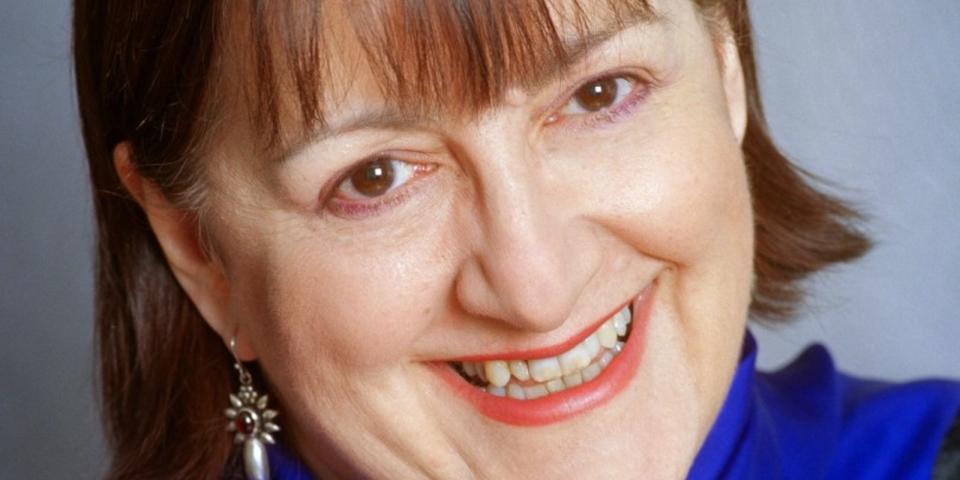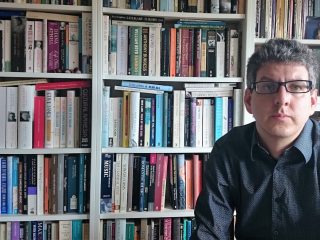
Judith Bingham
This month’s featured composer is Judith Bingham. Below are notes by Judith on all of her works for Oboe and Cor Anglais.
I learnt the oboe for a couple of years in my mid-teens, and it has to be said it was not a happy experience. I had always been a good singer, and I think the two techniques did not blend well. The memory is vivid though – problems with reeds, problems with fainting! My teacher, Paul Scott, tried to encourage me by showing off his own prowess. He demonstrated circular breathing and played the whole of the opening of Jesu, Joy of Man’s Desiring in one circular breath, but I was a shy and insecure child and felt put off by this, not challenged. It was like showing Mount Everest to a toddler and saying ‘off you go then!’ There were some terrifying moments: playing the opening of the Vaughan Williams arrangement of Greensleeves, and worse, being part of the traffic pile up that was our school orchestra’s attempt at Pictures at an Exhibition!! In the end I gave it up and took singing more seriously. I never picked up the oboe again, and for a while, felt a disinclination to write for it. But of course I did write for it eventually, in many orchestral and chamber pieces, and then finally, while on holiday on the Greek island of Patmos, I wrote a solo piece. It was premiered by Virginia Shaw, and then turned up on the Associated Board syllabus. Because of her performance, and her interest in Japanese music, I wrote a piece for oboe and koto called The Cruelty of the Gods, which was done at the City of London Festival. Since then I’ve written another solo piece – Dürer Portrait, for the Barbirolli Prize in 2013, and a solo cor anglais piece: Billingbear, commissioned by Christine Pendrill. She and I had worked together on an education project with the LSO, and I learned a lot from her. Then there was an oboe concerto, written for oboe and 11 strings, called The Angel of Mons, commissioned by the John Armitage Memorial Trust for the JAM concert at the City of London Festival, and played by a terrific young oboist called Michal Rogalski. This was without a conductor – the 11 solo strings were led by Jackie Shave. By dint of its WW1 subject it was then included in a BBC Symphony Orchestra concert at the Barbican, played by Nicholas Daniel, with a full string section and Marin Alsop conducting.
Although oboists have been flattering about my writing, I don’t feel that I am any more suited than any other composer at writing for the instrument. But I do still remember the fingering, oddly enough, and maybe this influences the difficulty of the music. I’m not really interested in extended techniques, more in expression and gesture. I know that I write like a singer, in breath lengths (probably my own breath lengths, not particularly long!) and that I have a singer’s idea of attack, used expressively and for colour. I like what I call the nasty, short tempered side of the oboe, -it has a tremendous emotional impact which can be fully exploited in solo pieces. There’s a great deal of music written for the oboe’s famous lyrical sound, and its pastoral colours, but I do really like the lower registers and the edginess that can be achieved, as well as the plaintive sounds of the higher registers. I am a fan of Berlioz and think that my over-indulgence in his music as a teenager has definitely influenced the way I write for the instrument.
The Island of Patmos
In June 2001, I spent several weeks on the island of Patmos in Greece. I chose it for its connections with St John and the Book of Revelations – the island is owned by the monastery of St John there. I wasn’t going to write any music while I was there, but an e-mail correspondence with the American composer Randall Davidson, whose wife Merilee is an oboist, started my mind turning around the idea of a solo oboe piece, and most of the music was conceived and written during that time. Living as I do in the centre of London, it was a very enjoyable experience to write this piece in romantically beautiful locations, and I hope the listener can hear in the music the clear, translucent colours of the Aegean sea and sky.
Although the island is dominated historically and geographically by the monastery, early mythology is of the goddess Artemis, and within the monastery itself you can see the ancient pillars of a temple to Artemis supposedly built by Orestes. All around the island, I felt that the deserted pine groves and remote unvisited ruins were haunted by those ancient wandering shades of Artemis and her brother Apollo and that somehow the strong masculine influence of St John and the church had been but impermanently grafted on. In some parts of the island time seemed to have stopped completely.
The music follows a progression of these thoughts: first, the light and the sea, and memories of goats balanced on steep cliffs, then more sensual images of Artemis and Apollo, the moon by day, and the distant sound of monastery bells. God speaks to St John, and Byzantine angels guard the Virgin on an ancient fresco. Finally the sound and colour of the sea return.
Dürer Portrait (2013)
This piece was inspired by the 1499 Dürer portrait of Oswold Krel – a merchant from Lindau, who got into a certain amount of trouble in his life because of his temper. The merchant is flanked by two wild men, naked and hairy, holding the Krel family’s coat of arms. Krel himself is clutching at his fur collar and is staring into a corner of the studio as if obsessing over something. So a sense of obsessive nervous anger is depicted in the first section of the piece, where there is an idée fixe of repeated notes, repetitions that seem to springboard more passion. The two qualities I like in the oboe are the sense of a gnawing kind of anger, and the well represented (in other composers) serene and still water expressivity. So the second section has a more inward looking sostenuto quality where the slower repeated notes seem more pleading and vocal. A strange dance made up of scotch snaps follows, where the obsession seems to be in the repeated rhythms. It fades into the serene slow section again. The music reaches out, but the dance returns like strange creatures hovering at the corner of a painting.
Oboe Concerto: The Angel of Mons (2014)
The Battle of Mons and the Retreat from Mons were the first encounters of WW1 between the Germans and the British Expeditionary Force. Although there were substantial losses, especially on the German side, the public focussed on several tales that spread (always second hand), of how the allies were saved by supernatural support from variously, angels, George and the Dragon, and the longbowmen of Agincourt. Curiously, the Belgian town of Mons has an annual re-enactment event of a fight with a dragon, called the Lumaçon, and the route followed by the soldiers coincided with the route taken by Henry V’s soldiers towards Agincourt. So history replays itself.
In this four movement piece, the title headings are from an alleged eye witness account of the Battle of Mons, August 28th, 1914.
‘We all saw it. First there was a sort of a yellow mist like, sort of risin’ before the Germans as they came to the top of the hill, come on like a solid wall they did–springing out of the earth just solid, no end to ’em. I just gave up. No use fighting the whole German race, thinks I; it’s all up with us. The next minute comes this funny cloud of light, and when it clears off there’s a tall man with yellow hair in golden armour, on a white horse, holding his sword up, and his mouth open as if he was saying, “Come on boys! I’ll put the kybosh on the devils.” … The minute I saw it, I knew we were going to win. It fair bucked me up–yes, sister, thank you. I’m as comfortable as can be.’ Lancashire Fusilier describes the Battle of Mons to nurse Phyllis Campbell; “The Angels of Mons.” London Evening News.
I liked the emotional progression through the story: the rise of the dragon of war, a sense of impending defeat, the intervention of supernatural forces, and a resurgence of courage ending in victory. Standing on the side of the road as it were, is a solitary figure symbolised by the oboist, who tries to intervene, reason, dissuade, but in the end is overcome by war rolling on implacably.
Billingbear
In 1995 I wrote a piece for an LSO education project – The Red Hot Nail – and met Christine Pendrill who was taking part in it. I thought then that she was a superb player and so was very happy to be asked to write a solo piece for her.
Billingbear was an Elizabethan mansion in Berkshire, built by the Neville family. It no longer exists but the park that was once its grounds still sits on the edge of Windsor Great Forest. The family had musical connections, and the piece uses a tiny motif from My Ladye Nevill’s Virginal Book as its main material. But the piece is essentially a ghostly experience of something intriguing, mysterious, that has gone. After the opening, in which a hunt leads us towards the house, there is a formal welcome, the sound of viols and then children echoing the hunt in their play. Finally, the rooms enigmatically called ‘Paradise,’ and the house again melts into the past.
The Cruelty of the Gods for oboe and koto
Japanese mythology tells the story of a cruel emperor god who send his daughter Orihime to the far reaches of the Milky Way.
Written for Virginia Shaw, and performed at the City of London Festival in 2006.
All music published by Peters. The Island of Patmos was recorded by Virginia Shaw on her CD Horizons.
About Judith Bingham
Born in Nottingham, and raised in Mansfield and Sheffield, Judith Bingham began composing as a small child, before studying composition and singing at the Royal Academy of Music in London. Her composition studies there with Alan Bush and Eric Fenby were later supplemented by lessons from Hans Keller. She was awarded the Principal’s prize in 1971, and 6 years later the BBC Young Composer award. Recent composition prizes include: the Barlow Prize for a cappella music in 2004, two British Composer Awards in 2004 for The Christmas Truce(choral) and Missa Brevis: The Road to Emmaeus(liturgical), one in 2006 for My Heart Strangely Warmdand the instrumental award in 2008 for Fantasia. She was once again nominated for an award in 2009 for Shakespeare Requiem, a Leeds Festival Chorus commission.



